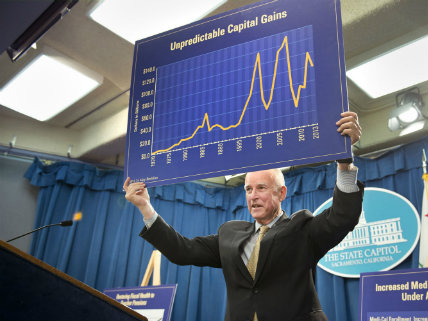California Teachers' Pension System Lowers Projection, Potentially Tripling What Taxpayers Will Owe
And how baseball can explain complicated pension math.

The California Public Employees Retirement System, or CalPERS, voted in December to lower the pension fund's discount rate—the projected annual investment returns for future years—from 7.35 percent to 7 percent, in two steps that will occur between now and 2020. It's a modest adjustment and one that leaves the fund with a discount rate that still might be too high, but even that small change is going to add billions to the state's annual pension tab.
Last week, the California State Teachers' Retirement System, or CalSTRS, followed suit, announcing plans to lower the discount rate from 7.5 percent to 7 percent over the next two years.
"Both decisions acknowledge that the funds have earned lower-than-expected returns in recent years. With less money from investments, the funds are turning to taxpayers and employees to shore up their finances," the Sacramento Bee reported.
Taxpayers will be hit hard by the change. Bloomberg, citing data from the California Finance Department, says the share of pension costs paid by state taxpayers will triple in less than a decade and might increase further if investment returns under-perform the 7 percent threshold.
Every government entity that runs a pension system has to forecast the future costs of those benefits in order to know how much must be contributed (often, politicians will completely ignore that bit of information, but that's beside the point for now). Funding for those future benefits comes from three sources: contributions made by public sector employees, contributions made by taxpayers via government budgets, and investment returns.
To make a prediction about how much money has to come from the first two sources, governments make predictions about future investment returns. For years, pension plans have been using overly generous assumptions about future investment returns, which has effectively hidden the true cost of these pension plans for public workers and taxpayers.
California's move to lower the projected rate of return for CalPERS follows a recent trend that has seen many cities and states similarly reduce their expectations.
It's important to remember that changing those future projections doesn't alter the total future cost of the system. Those benefits are still just as costly and still must be paid for, but reducing the amount of money coming from Pot Three (investment returns) means states and cities will have to get a larger share of the money from Pot One and Pot Two (contributions from employees and taxpayers, respectively).
Here's the other catch: the contributions from Pot One are locked-in because they are negotiated as part of collective bargaining agreements. Those totals could change somewhere down the line, but they won't be changing immediately to reflect the new calculus created by CalSTRS decision this week.
That means the extra money needed to fill the gap is coming from Pot Two—from you, dear California taxpayers.
Of course, it was always going to come out of your pockets anyway. Those projected future returns are something of a fiction anyway, useful for making budgetary projections but not a guarantee of anything.
This about it like this. The Los Angeles Dodgers are projected to win 95 games this year, according to FanGraphs, which, like pension forecasting, uses statistical models of what we know about past performance to gauge future happenings. The stock market, like a baseball season, is full of surprises. There will be unexpected downturns, critical injuries, and breakout stars (or stocks) that few predicted. Adjustments will be made on a daily basis. In the end, CalSTRS might earn 7 percent for the year and the Dodgers might win 95 games, but no one can guarantee either outcome with 100 percent certainty.
If the Dodgers fall short, though, fans will be merely disappointed. If CalPERS or CalSTRS falls short, those same fans (and everyone else in California) will have to pay extra to make up the shortfall.
That's why pension plans should use the lowest reasonable projections possible. Economists and pension experts differ on what those should be, with some preferring a discount rate near zero and others arguing for a rate pegged to long-term government bonds (somewhere in the vicinity of 4 percent or so). Most experts agree that, over the long-term, pension funds are unlikely to achieve returns of 7 percent or more.
There's no downside to having a lower projection. It's like being told your favorite baseball team is expected to win about 85 games. That's a good season, but not a great one. If they end up winning 95 games, you'll be thrilled. If you expect that they will win 95 games and they only win 85, it's a disappointment.
If pension plans are pegged to 4 percent annual returns, and they earn 7 percent, taxpayers will be thrilled to learn they don't have to contribute as much as they thought. Expecting 7 percent and getting only 4 percent leaves governments exposed to higher costs than expected and puts taxpayers on the hook.
"Adopting a higher discount rate than warranted by the pension's actual risk cannot reduce the true, net cost of a pension plan," wrote Anthony Randazzo and Truong Bui, pension analysts for the Reason Foundation, which publishes this blog, in a 2015 report. "Similarly, a plan that employs a low discount rate puts a larger burden on today's taxpayers, leaving smaller obligations for future generations. Either way, the total economic cost of the pension plan remains the same."
Moving to a lower discount rate means a more realistic picture of just how expensive California's public sector pension plans are. The actual costs are probably higher still.
Show Comments (115)